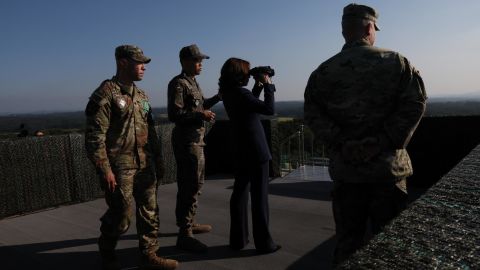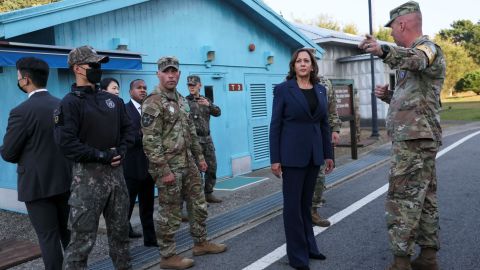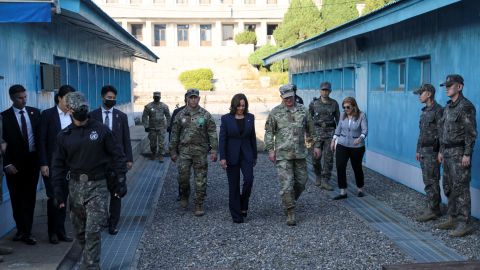CNN —
US Vice President Kamala Harris visited the Demilitarized Zone that divides North and South Korea on Thursday, the last stop on her four-day trip to Asia.
Harris condemned North Korea’s Kim Jong Un while standing on the heavily reinforced region, one day after Pyongyang fired two ballistic missiles into the waters off its east coast.
“It is clearly a provocation, and it is meant, we believe, to destabilize the region and we’re taking it seriously, and everyone should,” she said to reporters traveling with her.
Though Harris arrived in Asia this week on a trip crafted to attend the state funeral of former Japanese Prime Minister Shinzo Abe in Tokyo, she also met with Japanese, South Korean and Australian government leaders amid rising tension from China’s aggression in the South China Sea and North Korea’s ballistic missile program. Harris’ trip was meant in part to reaffirm Asian allies of the US’ intention to follow through on its security commitments in Indo-Pacific region.
Harris on Thursday became the most senior Biden administration official to stand just some feet away from the border to North Korea. During her tour, Harris went to Observation Post Ouellette where she used binoculars to look into the Hermit Kingdom. Images from reporters traveling with Harris showed that as she narrowed in on a tower with a small flap atop, some workers inside a building on the North Korean side looked back at her.
“I had no doubt that would happen,” Harris said, when told a US service member informed her that North Korean guards could be staring back at her.
While at the DMZ, the vice president also met with US service members and their families at the Camp Bonifas Dining Facility and thanked them for their service.
“These lives are forever benefiting because of your hard work and your dedication,” Harris told the troops.
And she wrapped her visit to the DMZ with a tour of T2 Conference Row where she received an operational briefing. But after her tour, Harris briefly misspoke when she referred to the US’ “alliance with the Republic of North Korea.” An official transcript from the vice president’s office released hours later corrected her remarks to “the Republic of Korea,” striking “North” from the record.
Still, Harris said, “The United States and the world seek a stable and peaceful Korean Peninsula where the DPRK is no longer a threat.”
Before venturing to the DMZ Thursday, the vice president met with South Korean President Yoon Suk Yeol, with whom she discussed the threat posed by North Korea, the “importance of peace” in the Taiwan Strait, cooperation on economics and technology, and other regional issues, according to the White House.
“The Vice President and the President reaffirmed our alignment on the Democratic People’s Republic of Korea (DPRK) and our goal of the complete denuclearization of the Korean Peninsula,” a White House readout of the meeting released afterward stated.
During the meeting, Harris called the US-South Korea alliance a “linchpin” of regional and global security. She also reaffirmed the “goal of the complete denuclearization of the Korean Peninsula,” and condemned North Korea’s “provocative nuclear rhetoric” and ballistic missile launches, according to a White House readout.
While in Seoul, Harris also met a group of female industry leaders before she was due to head to the DMZ – often described as one of the world’s most heavily armed borders.
The DMZ has long been a destination for US presidents and vice presidents on official visits to South Korea, where they have been photographed peering through binoculars into North Korean-controlled territory.

Joe Biden visited the DMZ as vice president but has not yet gone since becoming President. Donald Trump was the last president to visit the region. In 2019, Trump shook hands with Kim Jong Un and took 20 steps into North Korea, making history as the first sitting US leader to set foot in the country.
Harris’ visit comes a day after North Korea fired two short-range ballistic missiles from the Sunan area of Pyongyang, according to South Korea’s Joint Chiefs of Staff (JCS).
The missiles had a flight distance of about 360 kilometers (224 miles), an altitude of 30 kilometers (19 miles), and a speed of about Mach 6 – six times the speed of sound, said the JCS.

“The military has strengthened its surveillance and vigilance and it is maintaining a fully prepared posture while closely cooperating with the US,” it said.
This is North Korea’s 20th missile launch this year, according to CNN’s count, and follows another launch on September 25 – shortly before Harris arrived in the region.
After Harris departed South Korea to return to Washington on Thursday, the South Korean military detected two more short-range ballistic missiles launched from North Korea’s Sunchon area in South Pyongan Province on Thursday, South Korea’s Joint Chiefs of Staff (JCS) said in a statement.
Speaking aboard the USS Howard at the Yokosuka Naval Base in Japan on Wednesday, Harris criticized North Korea’s recent missile launches as “part of its illicit weapons program which threatens regional stability and violates multiple UN Security Council resolutions.”

At a news briefing on Wednesday, White House Press Secretary Karine Jean-Pierre declined to say whether the launch could have been timed to coincide with Harris’ visit, saying the tests are “not unusual” for North Korea.
The US and South Korea have also been conducting joint naval exercises featuring the USS Ronald Reagan aircraft carrier since Monday.





























